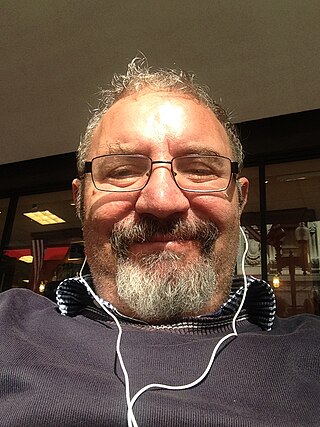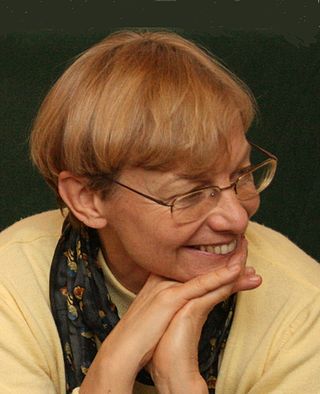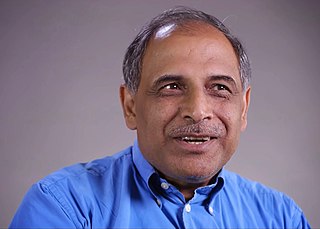Related Research Articles

The American Geophysical Union (AGU) is a 501(c)(3) nonprofit organization of Earth, atmospheric, ocean, hydrologic, space, and planetary scientists and enthusiasts that according to their website includes 130,000 people. AGU's activities are focused on the organization and dissemination of scientific information in the interdisciplinary and international fields within the Earth and space sciences. The geophysical sciences involve four fundamental areas: atmospheric and ocean sciences; solid-Earth sciences; hydrologic sciences; and space sciences. The organization's headquarters is located on Florida Avenue in Washington, D.C.

William Bowie, B.S., C.E., M.A. was an American geodetic engineer.

Rafael Luis Bras is a Puerto Rican civil engineer best known for his contributions in surface hydrology and hydrometeorology, including his work in soil-vegetation-atmosphere system modeling.
The William Bowie Medal is awarded annually by the American Geophysical Union for "outstanding contributions to fundamental geophysics and for unselfish cooperation in research". The award is the highest honor given by the AGU and is named in honor of William Bowie, one of the co-founders of the Union.
The Fred Whipple Award, established in 1989 by the Planetary Sciences Section of the American Geophysical Union, is presented to an individual who makes an outstanding contribution to the field of planetary science. The award was established to honor Fred Whipple. The Whipple Award includes an opportunity to present an invited lecture during the American Geophysical Union Fall Meeting.

Albert Francis Birch was an American geophysicist. He is considered one of the founders of solid Earth geophysics. He is also known for his part in the atomic bombing of Hiroshima and Nagasaki.
The James B. Macelwane Medal is awarded annually by the American Geophysical Union to three to five early career scientists. It is named after James B. Macelwane, a Jesuit priest and one of the pioneers of seismology. The medal is regarded as the highest honor for young scientists in the field of Geological and Planetary Sciences. In 1984, Mary Hudson became the first woman to receive the award.
Two international geophysical societies offer awards each year which are named in honor of Maurice Ewing; these are the American Geophysical Union and the Society of Exploration Geophysicists.
The Robert E. Horton Medal is given out by the American Geophysical Union to recognize "outstanding contributions to the geophysical aspects of hydrology". The award was created in 1974 and named after Robert E. Horton to honor his contributions to the study of the hydrologic cycle. It was awarded biennially until 1995 and then annually thereafter.

Louis John Lanzerotti is an American physicist. He is a Distinguished Research Professor of physics in the Center for Solar-Terrestrial Research at New Jersey Institute of Technology (NJIT) in Newark, New Jersey.

Ferhat Ozcep was a geophysicist and historian of science in Turkey. He was born in Zonguldak on 23 January 1968. He was a visiting scholar in the Department of the Science at Harvard University. He was professor of geophysics at Istanbul University.
Donald Lawson Turcotte is an American geophysicist most noted for his work on the boundary layer theory of mantle convection as part of the theory of plate tectonics. He works at the University of California, Davis.

Barbara A. Romanowicz is a French geophysicist and an expert on imaging the Earth's interior.
Alik Ismail-Zadeh is a mathematical geophysicist known for his contribution to computational geodynamics and natural hazard studies, pioneering work on data assimilation in geodynamics as well as for outstanding service to the Earth and space science community. He is Senior Research Fellow at the Karlsruhe Institute of Technology in Germany.
Carolina Raquel Lithgow-Bertelloni is a geophysicist known for her research on the role of subsurface processes in shaping the Earth. She was elected a fellow of the American Geophysical Union in 2021.
William L. Ellsworth is an American seismologist who is a research faculty member at Stanford University. His research covers a range of topics of earthquake science focusing on the physics of earthquake nucleation, earthquake hazard assessment, and active fault processes as studied through earthquakes. He is the 2021 recipient of the Harry Fielding Reid medal, the highest honor of the Seismological Society of America.

Upmanu Lall is an Indian-American engineer and founding director of the Water Institute at the Julie Ann Wrigley Global Futures Laboratory at Arizona State University. Lall also has a faculty appointment as professor in the School of Complex Adaptive Systems within the College of Global Futures. Prior to joining ASU in January 2024, Lall was the Alan and Carol Silberstein Professor of Engineering at Columbia University. He served as founding director of the Columbia Water Center. Lall studies how to solve water scarcity and how to predict and mitigate floods. In 2014, he was awarded the Henry Darcy Medal by the European Geosciences Union. He was named an American Geophysical Union Fellow in 2017 and their Walter Langbein Lecturer in 2022. He was elected a fellow of the American Association for the Advancement of Science in 2018, and has received the Arid Lands Hydrology and the Ven Te Chow Awards from the American Society of Civil Engineers. In April 2021 he was named to the “Hot List of the world’s 1,000 top climate scientists” by Reuters.
Kelin Wang is a senior research scientist and has worked for the Geological Survey of Canada since 1992. His research encompasses geodynamics and natural hazards, with major contributions in researching slow-slip events along the Cascadia subduction interface.
References
- 1 2 "Birch Lecture & Birch Lecturers, Awards - Tectonophysics". American Geophysical Union.
- 1 2 "Francis Birch Lecture, Recognizing Geophysics Scientists". American Geophysical Union.
- ↑ Soler, Tomás (2014). "William Bowie: Eminent Scientist and First Chairman (1926–1940) of ASCE's Surveying and Mapping Division". Journal of Surveying Engineering. 140: 2–11. doi:10.1061/(ASCE)SU.1943-5428.0000117.